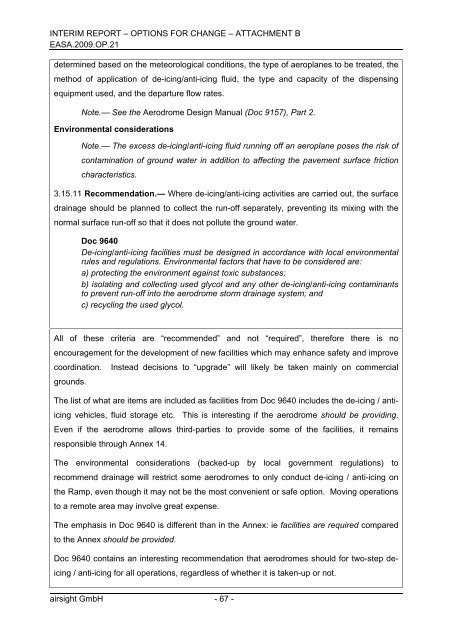Interim Report - Introduction - EASA
Interim Report - Introduction - EASA
Interim Report - Introduction - EASA
Create successful ePaper yourself
Turn your PDF publications into a flip-book with our unique Google optimized e-Paper software.
INTERIM REPORT – OPTIONS FOR CHANGE – ATTACHMENT B<br />
<strong>EASA</strong>.2009.OP.21<br />
determined based on the meteorological conditions, the type of aeroplanes to be treated, the<br />
method of application of de-icing/anti-icing fluid, the type and capacity of the dispensing<br />
equipment used, and the departure flow rates.<br />
Note.— See the Aerodrome Design Manual (Doc 9157), Part 2.<br />
Environmental considerations<br />
Note.— The excess de-icing/anti-icing fluid running off an aeroplane poses the risk of<br />
contamination of ground water in addition to affecting the pavement surface friction<br />
characteristics.<br />
3.15.11 Recommendation.— Where de-icing/anti-icing activities are carried out, the surface<br />
drainage should be planned to collect the run-off separately, preventing its mixing with the<br />
normal surface run-off so that it does not pollute the ground water.<br />
Doc 9640<br />
De-icing/anti-icing facilities must be designed in accordance with local environmental<br />
rules and regulations. Environmental factors that have to be considered are:<br />
a) protecting the environment against toxic substances;<br />
b) isolating and collecting used glycol and any other de-icing/anti-icing contaminants<br />
to prevent run-off into the aerodrome storm drainage system; and<br />
c) recycling the used glycol.<br />
All of these criteria are “recommended” and not “required”, therefore there is no<br />
encouragement for the development of new facilities which may enhance safety and improve<br />
coordination. Instead decisions to “upgrade” will likely be taken mainly on commercial<br />
grounds.<br />
The list of what are items are included as facilities from Doc 9640 includes the de-icing / antiicing<br />
vehicles, fluid storage etc. This is interesting if the aerodrome should be providing.<br />
Even if the aerodrome allows third-parties to provide some of the facilities, it remains<br />
responsible through Annex 14.<br />
The environmental considerations (backed-up by local government regulations) to<br />
recommend drainage will restrict some aerodromes to only conduct de-icing / anti-icing on<br />
the Ramp, even though it may not be the most convenient or safe option. Moving operations<br />
to a remote area may involve great expense.<br />
The emphasis in Doc 9640 is different than in the Annex: ie facilities are required compared<br />
to the Annex should be provided.<br />
Doc 9640 contains an interesting recommendation that aerodromes should for two-step deicing<br />
/ anti-icing for all operations, regardless of whether it is taken-up or not.<br />
airsight GmbH - 67 -

















